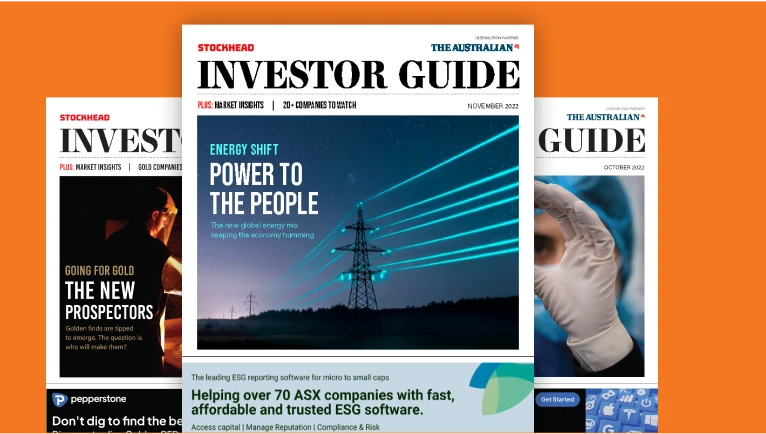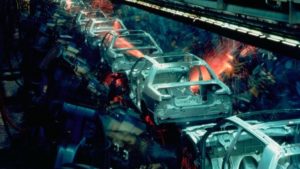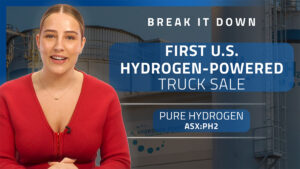US tariffs no hurdle to Pure Hydrogen’s zero emission vehicles ambitions

Pure Hydrogen sees US tariffs as no hurdle to its ambitions to boost its zero emission vehicles. Pic: Getty Images
- Pure Hydrogen believes its zero emission vehicles could capitalise on US tariffs
- Company’s largest competitors are Chinese, which have been hit with the highest tariff rates
- Vehicle orders expected to climb on success of existing orders
The wide range of tariffs introduced by US President Donald Trump on practically all countries in the world has wreaked havoc on the global economy and left companies scrambling to adapt.
The current pause on most of these tariffs is strictly temporary – and barring countries striking deals that will appease Trump, could return to disrupt markets again.
Despite this, there are companies such as Pure Hydrogen Corporation (ASX:PH2) which believe that the tariff situation actually presents an opportunity to be grasped with both hands.
Its managing director Scott Brown told Stockhead the company could be a winner in the provision of hydrogen fuel cell and battery electric vehicles as its largest competitor was actually China.
“At the current rates they are prescribing in the US, it’s simply unviable to build a truck in China, send it to the US and get tariffed at a rate of over 100%,” he said.
“That’s just not a viable situation. You are never going to get sales or money out of that.”
This contrasts with the flat 10% tariff that has been slapped on Australia. While not ideal if Australia is unable to get an exemption, Brown says it makes Aussie manufacturers more competitive, with China’s rate recently jacked up to 245%.
Australia’s tariff rate is also at least equal to or lower than other countries capable of building competing trucks such as Japan, Korea and the European Union.
“What we are looking to do is assemble trucks in Australia, get an Australian vehicle identification number, and with the way US tariffs treat it, the truck would be deemed an Australian product. Therefore it’d only be tariffed at 10%,” Brown explained.
Domestic competition in the US has also fallen by the wayside, with HFC truck makers Hyzon and Nikola closing shops without making good on their promise to revolutionise the transportation sector with green trucks.
“Nikola has been taken over by a battery-electric EV start-up car company, though it looks like they are just going to focus on BEVs,” Brown said.
“We consider that a win because we’re not going to have competition in the hydrogen space.”
Right products for the market
The other factor that PH2 is counting on to succeed in North America is having the right products for the market, namely the Taurus HFC Prime Mover – considered a Class 8 vehicle in the US and the rigid truck that can be used as a garbage truck or as an eight by four concrete mixer as it is manufacturing for Heidelberg Materials.
The Taurus Prime Mover provided by its subsidiary HDrive International can transport a gross 70t and has a range of ~600km, while the concrete mixer features an 8 by 4 axle configuration that provides enhanced stability and optimal load distribution, making it ideal for heavy-duty applications, and features a range of over 200km and a top speed of 100km/h.
It is also equipped with a 58kWh traction battery from CATL to provide reliable power and endurance along with a 200kW HFC, which both contribute to lower emissions, reduced operating costs and improved efficiency.
Speaking of the concrete mixer, Brown said that it could be one of the vehicles that the company will bring into the US, given demand for clean energy concrete mixers and existing subsidies for commercial operators in states like California, Pennsylvania and New Jersey.
“There are different rates depending on how big the truck is and so on, but essentially in California it can be up to US$240,000 per truck, which makes a big difference on the purchase price,” he added.
“There’s no doubt there’s a change in attitude in the federal government, but state governments are still holding on to those subsidies and also regulations that basically incentivise people to switch over to clean energy.
“And if you put it in context, California alone has about 40 million people, bigger than Australia. Even Republican states like Texas have some subsidies for clean energy vehicles.
“People generally do want to see some sort of transition, but it’s just a matter of how much taxpayer money they’re prepared to invest.”
Brown adds there’s pent-up interest as the previous Biden administration had poured about US$7bn into hydrogen production hubs, meaning there’s a lot of infrastructure being put in place that’s already been funded, looking for applications such as vehicles that can use that hydrogen.
Agreements and sales
Beyond the US, Brown says the company’s US$28m distribution deal with GreenH2 LATAM represents a terrific entry into Mexico.
“We’re essentially selling hydrogen equipment into that market, which the very green-orientated President Claudia Sheinbaum has enacted policies that are pro-hydrogen in that country,” he noted.
Sheinbaum has set an ambitious goal to boost renewable energy to 45% of Mexico’s electricity production by 2030.
Brown expects PH2 to sell US$28m of equipment in the first half of the 2026 calendar year and for the deal to deliver substantial profits.
“This is an absolute company maker without any doubt. Not only does it get us into that country, we think it could be the first of many projects in that country and it could be a real demonstration site for North America,” he said.
“There are a lot of other players in that marketplace in Mexico that are very interested in what’s been proposed and how it’s been proposed.
“We also think we’ll be able to sell vehicles into that market as our understanding is the Mexican government is looking into vehicle subsidies like those found in certain US states.”
Brown is also bullish about having a good range of HFC vehicles at a time when its competitors have either fallen over, or if they are Chinese, have been “tariffed out of existence”.
“We’re sort of sitting pretty. It feels like the Steven Bradbury moment where we are just skating along and then everyone else has fallen out of the race,” he said.
The company’s recent Australian orders are also encouraging as both Toll Transport and Heidelberg are high profile businesses within their respective industries.
Looking ahead
While PH2 will focus on assembling vehicles at a micro-factory in Australia for the US and Mexico, it would likely set up local production at some stage if there’s enough demand in those markets.
“For the first vehicles, it is easier to continue doing that and serve enough demonstrator vehicles into the market to get people confident in the build quality of our products,” Brown said.
“Once that’s established, we are pretty confident we will get a lot more orders.”
He adds that over time the cost of fuel cells, which are the single most expensive component in the company’s vehicles, will come down due to the investment that large companies have put into them.
“As that comes down in price, the price of trucks will come down, and they’ll be much more competitive without subsidies with diesel trucks,” Brown said.
“In the longer term I think you’ll find hydrogen as a fuel probably will be cheaper than diesel and people will switch because of the economics and not just the environmental benefits of having low CO2 and having no diesel fumes that could be detrimental to your health.”
At Stockhead, we tell it like it is. While Pure Hydrogen is a Stockhead advertiser, it did not sponsor this article.
Related Topics

UNLOCK INSIGHTS
Discover the untold stories of emerging ASX stocks.
Daily news and expert analysis, it's free to subscribe.
By proceeding, you confirm you understand that we handle personal information in accordance with our Privacy Policy.








